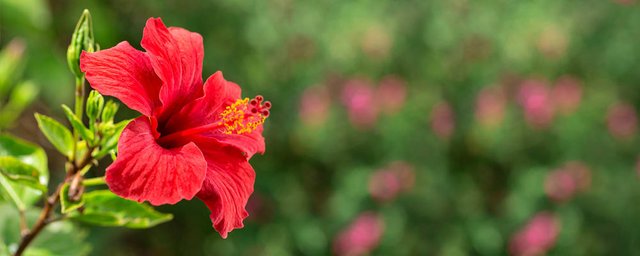
Hibiscus widely used for worshipping is Hibiscus. It is known to be the flower of Goddess Kali and is an essential item to be used to adorn her idol. Their bright red color is empowering on the goddess. This flower is commonly found in various regions within India and they grow all the year around.
.jpeg)
The flowers are large, conspicuous, trumpet-shaped, with five petals and their colors can be white to pink, red, orange, peach, and yellow or purple that are 4–18 cm broad. The flowers from various cultivars and hybrids can be either a single flower or a double flower.
At the bottom of every hibiscus bud is the calyx which is green in color. The pointed ends of the calyx are the sepals. When the hibiscus begins to bloom, the petals begin to grow which contains multiple petals and multiple colors. The ovary and other female parts of the flower lie in the main structure of the hibiscus, the pistil, which is long and tubular. The hibiscus has both male and female parts on the same flower. The five hairy red spots on the top of the flower is the stigma (female part) of the flower. The stigma is located at the end of the style branch. At the top of the pistil is known as the stigma, where pollen is collected, and in the middle is the style, which is the section that the pollen travels down to the ovary. The ovary lies at the bottom of the blossom and the hibiscus has only one ovary which is superior.
The male part (stamen) of the flower consists of stem-like filaments and each filament ends with the pollen-producing anther. The anthers, which release the pollen, sits on the filament and these two organs make up the stamen, the male part of the flower. Overall, the hibiscus is a dicot, with solitary (axillary), complete, perfect flowers, which have a superior ovary, regular symmetry, and axile placentation. They have five carpels, five locules, five sepals, and the number of stamens may vary.
The root is a branched tap root. The stem is aerial, erect, green, cylindrical and branched. The leaf is simple, with alternate phyllotaxy and is petiolate. The leaf shape is ovate, the tip is acute and margin is serrated. Venation is unicostate reticulate. (Venation is branched or divergent.) Free lateral stipules are present.
This post was resteemed by @steemvote and received a 3.58% Upvote. Send 0.5 SBD or STEEM to @steemvote
Downvoting a post can decrease pending rewards and make it less visible. Common reasons:
Submit
Impressive photography 🙂
Downvoting a post can decrease pending rewards and make it less visible. Common reasons:
Submit
Thanks man
Downvoting a post can decrease pending rewards and make it less visible. Common reasons:
Submit